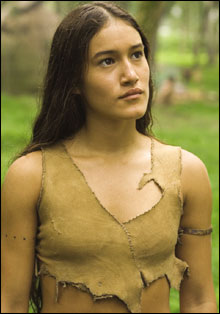 The New World begins and ends with water, imagery that makes it clear where director Terrence Malick, in his much-anticipated follow-up to 1998’s The Thin Red Line, is coming from. Water is a medium of voyage and discovery, and the world that lies beyond it is indeed “new.” It’s America as seen by 17th-century English adventurer Captain John Smith (Colin Farrell), who finds and loses love with Pocahontas (Q’orianka Kilcher), the Powhatan woman who saves his life.
The New World begins and ends with water, imagery that makes it clear where director Terrence Malick, in his much-anticipated follow-up to 1998’s The Thin Red Line, is coming from. Water is a medium of voyage and discovery, and the world that lies beyond it is indeed “new.” It’s America as seen by 17th-century English adventurer Captain John Smith (Colin Farrell), who finds and loses love with Pocahontas (Q’orianka Kilcher), the Powhatan woman who saves his life.
The shallowness of Malick’s epic may bewilder, but he’s nothing if not systematic about it. The actors aren’t permitted to go near psychological depth — a constraint that probably encouraged newcomer Kilcher, who makes an endearing wood nymph, though it seems not to have helped Farrell, who, held down to being either brooding or bemused, looks mainly uncomfortable. (A severely restrained Christian Bale as John Rolfe, the gentle tobacco planter who marries Pocahontas, comes off best.) Who are these people? For Malick, they’re unreal and enigmatic, existing only on the shifting plane on which others see them. The fact that several characters recite monologues in voiceover does nothing to deepen them or bring them closer.
The first encounter between the English and the people they call the "naturals" should be momentous, but Malick treats it as just an incident among many, one that, like every scene in the film, has started already before the film catches up to it and ends before its significance can be pinned down. The elliptical cutting keeps the images from becoming oppressive in their beauty, but the images still have that unshakable pompousness that has been Malick’s trademark since Days of Heaven. The extreme low angle is his signature shot: the camera frequently peers up at trees, the sky, or people. A good thing about The New World is its willingness to throw its images away rather than dwell on them.
The sound design is resourceful in its refusal to link causes to effects. In the big battle scene, the arbitrary and selective sound mix hovers over the discreet images, implying a freedom to escape from chaos. Much dialogue is whispered or muttered, and the visual fragmentation makes it hard (as in an Orson Welles film) to match up the lines with the image of the speaker or the space of the scene. Malick’s style even begs the question whether his cipher-like characters ever hear or understand each other. When, late in the film, Smith tells Pocahontas, “It seems as if I were speaking to you for the first time,” the comment says more about Malick’s æsthetic than it does about the two characters’ relationship.
Time itself is shallow in The New World, which though its narrative covers a considerable span creates little sense of time passing. Instead, the film suggests an ongoing clash of obstinate, incomprehensible moments. The pace is fast, because the scenes are fragmentary, but since their succession implies a potential vastness of time from which they’ve been drawn, the overall impression is sluggish. Malick takes pains to keep scenes from gathering to any climax, coherence, or fullness — an effort that’s emphasized by his heavy use of the slow, spiraling build-up of the Vorspiel of Wagner’s Das Rheingold. The very story of The New World is a critique of the idea of culmination. What could be more desultory, arbitrary, and absurd than the destiny of Pocahontas, or that of Smith, as the film shows them? The multi-layered film Malick has made of these destinies is not without interest, but it’s stilted and remote — the work of an artist, no doubt, but one whose way of making art is academic and ponderous.